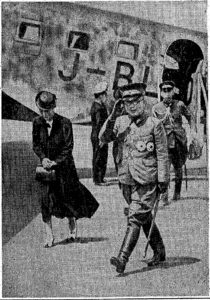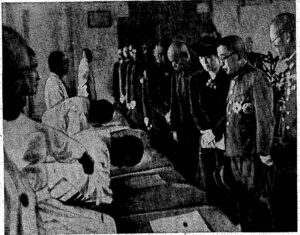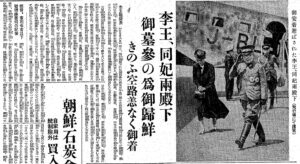On October 23, 1944, during one of the darkest chapters of Imperial Japanese colonial rule over Korea, the entire peninsula was mobilized for a synchronized prayer toward Tokyo's Yasukuni Shrine. At precisely 9:15 AM, every Korean was compelled to bow in reverence to Imperial Japan's war dead, who were enshrined as gods. This extraordinary event, designed to demonstrate loyalty to the Empire, marked a departure from the usual rituals of the time.
 |
| Original caption: Bereaved families advancing and paying respects before the Gokoku Shrine altar |
Under colonial rule, daily life in Korea was punctuated by strict, state-imposed ceremonies. At 7:00 AM each morning, Koreans were required to perform remote worship (宮城遥拝) toward the Imperial Palace. At noon, they observed a moment of silence (正午の黙祷) to honor Japan's war dead. These two times of the day were usually marked by loud sirens. However, this particular nationwide prayer at 9:15 AM was conducted in the absence of sirens to make the act feel more solemn and hallowed. Every Korean was expected to participate, with members of local neighborhood cells (patriotic groups) strictly organized to ensure compliance. Even buses and trains stopped at that moment, forcing passengers to partake.
The night before, on October 22, a "spirit-summoning ritual" (招魂の儀) was held. This sacred ceremony was believed to summon the spirits of Japan's Imperial war dead so they could be worshiped as gods (新祭神) the following day.
The prayer ceremony included Korean royalty such as Yi U and Yi Geon, as well as high-ranking military officials, the Governor-General Abe Nobuyuki, and the families of the deceased.
This forced mass worship was a chilling manifestation of Imperial Japan’s assimilation policies, aimed at erasing Korean identity and replacing it with blind devotion to the Empire. The ritualistic nature, combined with the total control over public and private life, reflects the deep cultural and spiritual subjugation that Koreans endured.
The site of the prayer ceremony, the Gokoku Shrine, no longer exists today. However, the 108 stone steps that were once part of the shrine remain today as part of the Huam-dong neighborhood in the Yongsan District of Seoul, known locally as the 108게단. Visitors can now ride up these stairs using an elevator.
[Translation]
Gyeongseong Ilbo (Keijo Nippo) October 23, 1944
Grateful Worship of Yasukuni Shrine
Today at 9:15 AM
A Time for National Prayer
In conjunction with the temporary grand festival at Yasukuni Shrine, the Korean Federation of National Power, alongside mainland Japan, designated 9:15 AM on October 23rd as a 'Time for National Prayer,' during which the entire Korean peninsula would offer devout prayers. At the specified time, all patriotic group members will conduct one minute of prayer to Yasukuni Shrine at their respective locations. However, no signals such as sirens or whistles are to be used; instead, the prayer time is to be announced via radio. On trains, buses, or in places with large gatherings, it is the responsibility of the person in charge to provide instructions.
At the front of the shrine in Tsuruoka, the pure white torii gate stood tall against the clear autumn sky, exuding an exceptional sense of purity. From the early morning of the 22nd, a continuous stream of people came to pray for the nation's inevitable victory and to honor the loyal spirits who protect the country. Even the black kites soaring above the deep green of the ancient pine trees seemed to eternally praise the achievements of the heroic spirits who laid the foundation for the everlasting prosperity of the empire, burying their bones across Greater East Asia.
At 2:00 PM, eighty-two bereaved families of Yasukuni Shrine were guided by staff to a special bus that stopped in front of the shrine approach. As they gazed up at the torii gate, passed beneath it, and ascended the stone steps, their hearts trembled with profound emotion, overwhelmed by thoughts of their beloved sons and husbands, now deified. They were then escorted to a special pavilion for rest, where they received heartfelt hospitality from the Patriotic Women's Association.
The site for the remote worship ceremony was located on the northwest side of Gokoku Shrine, halfway up a hill, with four large temporary pavilions arranged in a row. Red and white curtains extended cleanly and elegantly from the plaza in front of the shrine, along a newly constructed sand pathway, enclosing the ceremonial area. At the altar, with sacred evergreen branches as the centerpiece, offerings were arranged from various dignitaries who lined up to the right and left of Changdeok Palace. The sand path, meticulously prepared, awaited the participants: Prince Yi U, the family of Prince Yi Geon, as well as the Ministers of the Army and Navy, the Governor-General, and military officers and organizations stationed in Korea.
 |
| Soldiers lining the grounds for the spirit summoning ceremony. |
Before the main ceremony, a presentation of Imperial gifts bearing the chrysanthemum crest was conducted. In front of the shrine plaza, all the bereaved families assembled in a straight line. The families of the Imperial Army received their gifts from Major General Nakai, while those of the Imperial Navy received theirs from Navy Captain Yamaguchi. Among the bereaved families, there was an elderly Korean father, dressed in traditional Korean durumagi and black leggings. The purple tassels and silver sakura of the bereaved family badge, as well as the green ribbon with the silver sakura of the ceremony participation badge, shone brightly. Hands trembling with emotion, they reverently held the gifts they had received.
Following this, commemorative items and souvenirs were distributed. These gifts, thoughtfully prepared by the Imperial Army and Navy Ministries for the bereaved families, included sacred amulets, small altars, sacred cups and sake, ceremonial sweets, illustrated scrolls of Yasukuni Shrine, postcards, framed photographs, and hardtack from both the Imperial Army and Navy to evoke memories of the front lines. Additional items included furoshiki cloths adorned with Yasukuni Shrine designs, furoshiki cloths from the Military Support Division, a bag of chestnuts from the Red Cross, biscuits from the Korean branch of the Military Support Association, shopping bags from the Seoul sub-branch chairman of the Military Support Association, apples from the Maeil Sinbo newspaper, and household utility bags. These heartfelt gifts were presented to honor the families who had made the noble sacrifice of offering their husbands and sons to the nation.
 |
| Bereaved families of war dead receiving Imperial gifts. |
At 4:15 PM, participants, beginning with the division commander’s vehicle, arrived one after another. At 4:30 PM, the bereaved families solemnly proceeded to the front of the shrine and underwent purification rites, marking the start of the grand and dignified ceremony.
Photograph: Bereaved families advancing and paying respects before the Gokoku Shrine altar (above). Presentation of Imperial gifts with profound emotion.
A Solemn and Heartfelt 'Broadcast'
The Bereaved Sob During the 'Soul-Summoning Ceremony'
Amid the sacred grounds of Tsuruoka, where scattered autumn leaves adorned the landscape, the sound of rustling pines seemed to weep gently in the wind. The somber atmosphere of the soul-summoning courtyard at the Gokoku Shrine in Seoul was imbued with the devout prayers of 26 million people from the Korean Peninsula, as the spirits of the fallen were now enshrined as gods.
The Yasukuni Shrine ceremony in Korea was conducted with great solemnity, synchronized with the grand festival at the Imperial capital’s Yasukuni Shrine, and began at 5:40 PM on October 22nd with a live broadcast from the ceremonial site. Although the participants’ physical presence could not reach the sacred Yasukuni forest, the 83 bereaved family members in attendance listened intently to the grandeur of the shrine from afar. Swallowing their sobs, they clasped their hands tightly in reverence.
As twilight gently descended upon the sacred grounds, the altar stood opposite the designated gathering spot, where the bereaved families solemnly and devoutly assembled in dense groups. Despite the chill of the autumn breeze, they felt an inexplicable sense of comfort as they awaited this holy moment.
At 5:40 PM, through the microphone, the reverent voice of Chief Priest Suzuki delivered an imposing and extended eulogy, praising the achievements of the heroic spirits. A young widow, mourning her late husband and his younger brother, adjusted her short bob hairstyle and straightened her collar with quiet determination. In the purified space, the sudden and resonant sound of a ground-shaking cry of salutation filled the air. For a brief moment, the lights of the ceremonial site were extinguished, and everything in the sacred grounds was enveloped in jet-black darkness.
The faint and divine sound of reeds being rustled emerged, accompanied by solemn military music emanating from the distant Yasukuni forest. The melody reached the ears of the bereaved families on the Korean peninsula, gradually intensifying in emotional power. Throughout the site, restrained sobs broke free from those unable to hold back their feelings.
‘The heroic spirits of the warriors who soared through the skies and sailed across the seas now rest peacefully and serenely in the sacred shrine that protects the nation.’ At these words, spoken with a trembling voice by the announcer, elderly mothers and fathers pressed white handkerchiefs to their tear-streaked faces. As parents of sons, as wives of husbands, who among them could not think of their loved ones? These cherished individuals have now returned as gods who protect the nation. In that moment, what greater honor, what greater joy, could there be? The tears streaming down the cheeks of the bereaved are pure and noble, tears that only the Japanese people can truly understand.
The solemn and sacred ceremony of transferring the divine spirit, enshrined on the revered sacred carriage, was meticulously broadcast. The bereaved families, receiving it with the eyes and ears of their hearts, were unable to hold back their tears, momentarily surrendering to overwhelming emotion. The attendees, too, straightened their collars in reverence.
Thus, at 7:15 PM, the spirits of the heroic souls were permanently enshrined in the main hall, with the divine presence deeply instilled in Yasukuni Shrine. Following this, the bereaved families and attendees offered their final respectful worship. The ceremonial site was then brightly illuminated, and the families, who had successfully enshrined the souls of their loved ones as gods across the distant mountains and rivers of the peninsula, bore expressions of profound relief and a renewed determination to carry on the legacy of the heroic spirits with unwavering resolve.
Afterward, addresses were given by the Ministers of the Army and Navy (read by the Seoul Division Commander) and by Colonel Koya, a member of the ceremony committee. With these, the Yasukuni Shrine Korean Regional Ceremony concluded without incident. The sixty-five bereaved families associated with the enshrined spirits from the peninsula, deeply moved, retired to their lodgings with a sense of peace and fulfillment in their hearts.
[Transcription]
京城日報 1944年10月23日
感激の靖国遥拝
きょう午前九時十五分
国民祈祷の時間
靖国神社臨時大祭にあたり朝鮮聯盟では内地とともに二十三日午前九時十五分を”国民祈念の時間”とし、全半島一斉に敬虔なる祈念を捧げることに決定した。同時刻を期し全愛国班員は各々その所在で靖国神社に一分間の祈念を行うがサイレン、気笛などの合図は行わず、ラジオによる祈念時間の放送をなす予定であるが汽車、電車等においては乗務員、多数集会の場所では責任者が指示をすることになっている。
鶴ヶ丘の社頭秋空に高く映ゆる純白の大鳥居も一入清い二十二日早朝から護国の忠霊に皇国必勝を祈願する人々は、ひきも切らない、濃き緑の老松を截って飛ぶ鳶も皇国万代の隆昌の礎となって骨を大東亜に埋めた英霊の勲を永久に讃うが如くである。
午後二時係員に導かれた靖国の遺族八十二名が特別バスを参道前に止める。見上げる鳥居をくぐって石段を登る胸の中は今やあまりにも尊く神と化す我が子我が夫を想い仰ぐ感動に顫えているのだ。直ちに特設幕舎に入って休憩。日婦の心づくしの接待をうける。
遥拝式典場は護国神社の西北側、丘の中腹に四つの大幕舎を連ね紅白の幕は神社前の広場から急設の砂道に清く長く張られて式場を囲む。祭壇には真榊を中心にした左右の昌徳宮、李鍝公、李鍵公家を初め陸海軍大臣、総督、軍司令官以下在鮮軍官および団体よりの供物が匂い並び砂道の節目も正しく諸員参列を待つ式典に先立ち畏きあたりより御下賜の御紋菓伝達式があり社前広場の伝達処には全遺族整列。陸軍側遺族は中井少将より海軍側遺族には山口海軍大佐よりそれぞれ伝達を受けたが遺族の中には周衣(ツルマキ)に黒脚絆の半島老父も混じり、紫の房銀の桜の遺族章、緑のリボンに銀桜の式典参加章が一入輝き賜品を押し頂く手も感動にふるえる。
続いて記念品並びにお土産の授与があり、その内容は陸海軍省が心尽くしの遺族への贈りものの数々、神札、神床、神盃神酒、神菓、靖国神社絵巻、絵葉書、写真額それに前線をしのぶ陸海軍それぞれの乾パン、靖国神社の絵入風呂敷、軍人援護部からの風呂敷、日赤からの栗一袋、軍人援護会朝鮮本部からのビスケット、同府分会長からの買物鞄、毎日新報からの林檎、風呂敷、家庭用雑囊など御国へ夫を、子を捧げた栄の家への温かい贈物である。
四時十五分師団長の自動車を初め参列諸員続々と到着四時三十分遺族一同社前に参進して修祓を受け、いよいよ荘厳な式典に入った。
写真=参列の遺族護国神社神前に参進拝礼(上)と感激の御下賜品伝達
胸迫る厳かな”電波”
”招魂の儀”に遺族の嗚咽
紅葉まばらな鶴ケ丘の神域に松籟がサヤサヤと咽ぶかに鳴り、森厳の気一入満つる京城護国神社招魂齋庭に半島二千六百万の敬虔な祈りを籠めて英魂今ぞ神鎮まる靖国神社朝鮮地方式典は皇都靖国の祭典と時を同じくして二十二日午後五時四十分から祭典式場よりの実況放送開始と同時にいと厳かに執行され、現し身こそ靖国の杜に額づかねど参列遺族八十三名は遥けき靖国の威儀に耳傾け嗚咽の声を呑み、しっかと手を合わせたのである。
神域にひたひたと宵闇迫る齋場祭壇向合いの定めの位置にぎっしりと虔ましく群れた今宵の遺族には肌寒い秋風も何か知ら心楽しく感ぜられ聖なる一時を待受ける。
やがて午後五時四十分、マイクを通じ鈴木宮司の荘重な祭詞が英霊の勲を讃えて長く長く尾を曳いて流れる。今は亡き夫の弟を追う若き未亡人がいじらしいオカッパをゆすりあげ襟を正す。水を打ったような浄域にオーオーと地の底から湧きあがる警蹕の声が耳を打つ。一時式場の灯火は搔き消され神域のあらゆるものは一斉にぬば玉の闇に沈んだ。神々しい菅掻きの音がかすかにかすかに洩れ、荘重な軍楽の調べがはるけき靖国の杜から今半島の遺族らの耳朶をゆすり次第に昂ぶる。感情を抑えんとして押え得ざる嗚咽がそこここにあがる。
”天翔けり海を往きにし勇士の英霊平らけく安らけく今護国の御社に遺りまします”放送員のうるんだ声に早や白いハンカチを顔に当てる老母、老翁、人の子の親として、人の子の妻としてだれか肉身を思わぬ者があろうか。その親しき者が今国護る神として還えります一瞬、これ以上の光栄、これ以上の喜びが又とあろうか。遺族達の頬を流れているであろう泪は日本人のみが知る清くおおらかな涙である。
厳かに尊き御羽車に奉戴された神体奉遷の儀はこまごまと放送され、心の目、心の耳でじっと迎えまいらせる遺族達は涙せきあえず暫し感動に身をゆだね参列諸員又厳然と襟を正す。
かくして午後七時十五分英魂永えに本殿に安置され靖国のみやしろ深く神鎮まったのである。ここで遺族、参列諸員は再びうやうやしく遥拝を終れば式場にはあかあかと灯火が点ぜられ、遥けき半島の山河超えてつつがなく肉親の魂を神と祀った遺族たちの顔には美しい安堵の色と英霊の名を継いであくまでも勝ち抜く決意がしっかりと刻まれていた。ついで陸海軍大臣挨拶(京城師団長代読)式典委員小家大佐の挨拶あって靖国神社朝鮮地方式典は滞りなく終了し、参列の半島関係祭神六十五柱の遺族たちは感激を胸に心も晴々と宿舎に入った。
Source: 키워드 검색 - 신문 검색 - 대한민국 신문 아카이브








